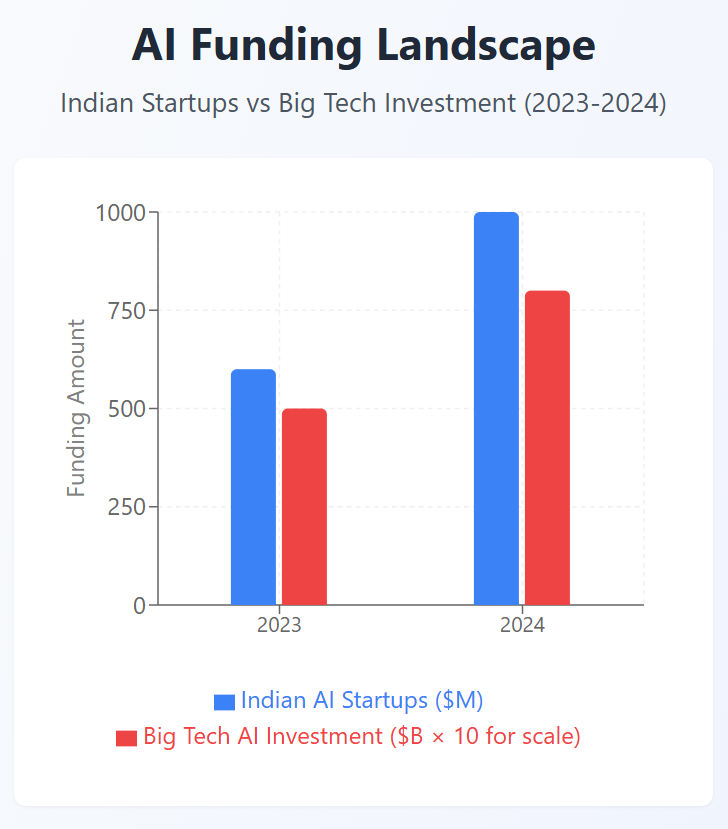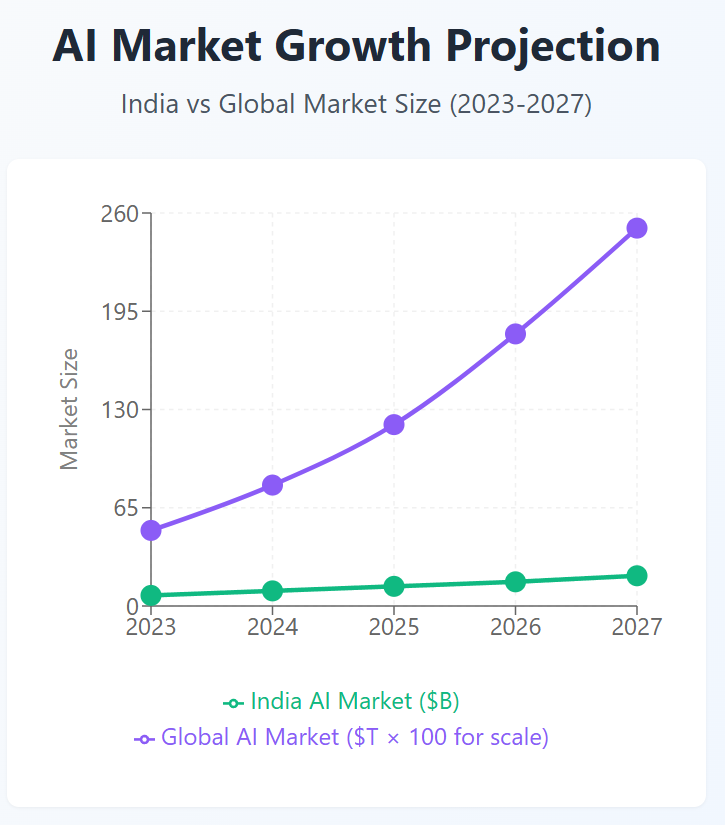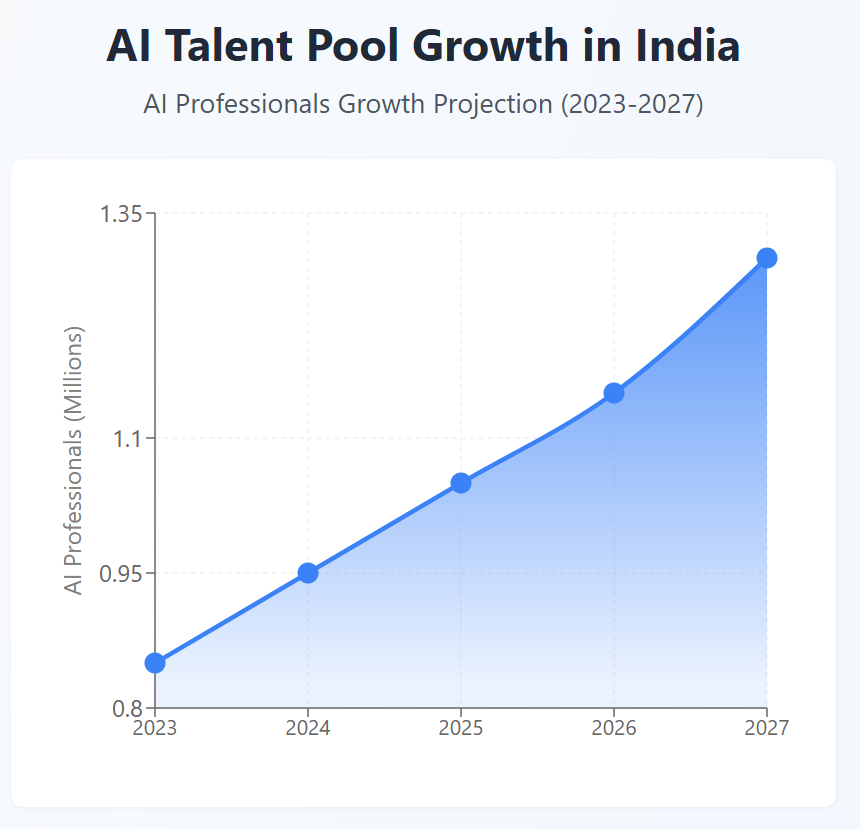India’s AI Stack Triumphs: Can Startups Outshine Global Big Tech?
India is rapidly emerging as a global AI powerhouse, leveraging its unique digital public infrastructure, India Stack, and a burgeoning startup ecosystem to challenge the dominance of global Big Tech. With initiatives like the IndiaAI Mission and a robust talent pool, India is carving a niche in the AI landscape. But where do Indian startups fit in this high-stakes race? This article explores India’s AI Stack, its competition with Big Tech, and the pivotal role startups play, supported by data-driven insights and visualizations.
Table of Contents
India’s AI Stack: A Foundation for Innovation
India Stack, comprising Aadhaar, UPI, and other digital public goods, has revolutionized access to services, enabling scalable, secure solutions for 1.4 billion people. The next evolution, India Stack 2.0, integrates AI to democratize technology, addressing local challenges like vernacular language processing and financial inclusion. The IndiaAI Mission, launched in 2024, bolsters this with a ₹10,371 crore investment, including 18,693 GPUs for startups and researchers, and initiatives like Bhashini for linguistic AI.
In contrast, Big Tech giants like Google, Amazon, and NVIDIA dominate globally with proprietary AI models, cloud infrastructure, and massive compute resources. Their strengths lie in scale, funding, and established ecosystems, but their solutions often lack the hyper-local focus of India’s AI Stack.
Startups: The Catalysts of India’s AI Revolution
Indian AI startups are uniquely positioned to leverage India Stack’s infrastructure and local data to create tailored solutions. Over 3,000 AI startups have emerged since 2020, raising $1.5 billion, with 100+ focused on generative AI. Companies like Krutrim, India’s first AI unicorn, and Sarvam AI, tasked with developing a sovereign LLM, exemplify this momentum.
Table: Indian AI Startups vs. Global Big Tech
| Aspect | Indian AI Startups | Global Big Tech |
|---|---|---|
| Focus | Localized solutions (e.g., vernacular AI, agri-tech) | Global, generalized AI models |
| Infrastructure | India Stack, IndiaAI Mission (10,000+ GPUs) | Proprietary cloud (AWS, Google Cloud, Azure) |
| Funding | $1.5B since 2020, growing VC interest | Billions in R&D, e.g., OpenAI’s $10B+ valuation |
| Strengths | Agility, local data, cost-effective innovation | Scale, global reach, advanced compute |
| Challenges | Scalability, global competition, talent retention | Regulatory scrutiny, lack of local customization |
Insights from Data
- Market Growth: India’s AI market is projected to reach $17–22 billion by 2027, growing at a 40% CAGR, driven by startups in healthcare, agriculture, and BFSI. Globally, AI is expected to contribute $15.7 trillion by 2030, with Big Tech leading in infrastructure.
- Talent Pool: India boasts the third-largest AI talent base, with 1.25–1.35 million skilled professionals by 2027, making it a hub for startups and Big Tech R&D centers.
- Investment Trends: In 2024, Indian AI startups secured $1 billion in venture funding, with 25% allocated to AI-focused ventures, compared to Big Tech’s multi-billion-dollar R&D budgets.
Graph 1: AI Funding Comparison (2023-2024)

Graph 2: AI Market Growth Projection (2023-2027)

Graph 3: AI Talent Pool Growth in India (2023-2027)

Where Startups Fit In
Indian startups thrive in niche, high-impact areas where Big Tech’s generalized models fall short. For instance:
- Cropin uses AI to digitalize agriculture, reducing losses for farmers across India.
- JIFFY.ai offers no-code AI platforms for BFSI, streamlining operations for SMEs.
- VisualDub provides lip-sync and voice cloning for media, catering to India’s multilingual market.
These startups leverage India Stack’s APIs and local data moats, offering cost-effective, scalable solutions. However, they face challenges like talent poaching by Big Tech, with firms like Motive Technologies expanding in India, and regulatory hurdles, as seen in debates over AI ethics.
Strategic Advantages and Challenges
India’s AI Stack offers startups a unique edge:
- Cost Efficiency: The IndiaAI Compute Portal provides subsidized GPU access at ₹100/hour, compared to global rates of $2.5–3/hour.
- Local Relevance: Bhashini’s linguistic data supports AI in 22 Indian languages, a market Big Tech has yet to fully tap.
- Public-Private Synergy: Partnerships with Google, NVIDIA, and Reliance enhance startup capabilities.
However, startups must navigate:
- Scalability: Limited global reach compared to Big Tech’s infrastructure.
- Innovation Depth: VCs demand proprietary data and defensible AI models, which many startups lack.
- Regulatory Risks: India’s AI policies, while supportive, impose ethical compliance, unlike Big Tech’s lighter scrutiny for indigenous LLMs.
The Road Ahead
India’s AI Stack positions startups as agile innovators, complementing rather than competing directly with Big Tech. By focusing on verticals like agriculture, healthcare, and vernacular AI, startups can address local needs while scaling globally. The IndiaAI Mission’s infrastructure and Google’s accelerator programs provide critical support, but startups must prioritize proprietary data and customer-centric design to outshine Big Tech’s dominance.
In conclusion, India’s AI Stack empowers startups to carve a distinct path in the global AI race. While Big Tech leads in scale, Indian startups’ localized innovation and government-backed infrastructure make them formidable players. The synergy of India Stack 2.0 and startup dynamism could redefine global AI, ensuring India not only competes but co-authors the future of technology.
also read : The Rise of Clean Energy Businesses in India’s Green Revolution
Last Updated on: Thursday, July 24, 2025 2:54 pm by Siddhant Jain | Published by: Siddhant Jain on Thursday, July 24, 2025 2:53 pm | News Categories: Technology, Business Max News, India News, News, Trending